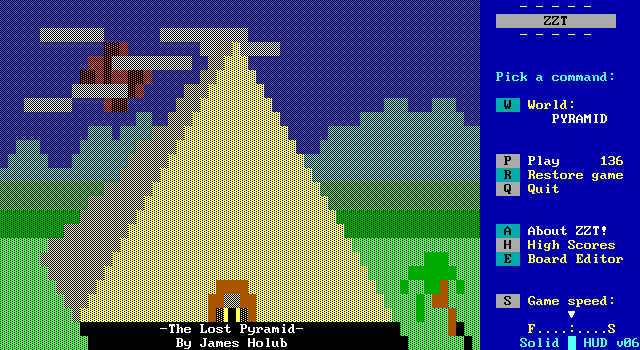
After a month of guides, I found myself looking for a suitable game to select for a Closer Look. It had been long enough that any ideas that weren't written down had long been forgotten, and what has been written down wasn't really striking me as what I needed to get back into the swing of things. I'm always the first to admit that many features the Museum of ZZT has were developed because I'd benefit from them, with a hope that others might find them useful as well. So, as I often find myself doing when I'm not sure what to play next, whether for a stream or article, I hit up my old friend, Roulette. Reroll after reroll, nothing was captivating me, until I saw this lovely little title screen on a game from the first half of 1992.
Flipping through the file viewer and playing a few boards myself, I was quickly drawn in. The Lose Pyramid is in that sweet spot of ZZT worlds that I find myself to be a big fan of these days. Distant enough from Town to feel like it's own thing, but still maintaining a lot of the values of the original worlds. 1992 is a ripe year for such games, as those who found ZZT early on have enough of a grasp on things to make some very well polished experiences. This is a year where authors (including James Holub here) like Chris Jong (The Lost Monkeys, Carlos DaSilva (The Ruby of Resurrection), Al Payne (Toxic Terminator) start making some games easily worthy of including wholesale in ZZT's Revenge or by the board in Best of ZZT. These authors (barring Al Payne) had the misfortune arriving too late to make it into these official releases. Their loss is our gain however, as free from a looming deadline, these authors could create freely and publish when they were ready where the games would instead be made freely available... if you had access to the right file sharing networks at least.
The Lost Pyramid is the second known release by James Holub, and raises the quality significantly between it and his initial release of The Stolen Gems. There's a lot of praise in store for this early adventure that has some very impressive graphics and proto-shading in a pre-STK world. The game makes excellent use of built-ins, with some clever designs using more unconventional components like blink walls and conveyors that create some action boards that make it a treat to play. Then there are the puzzles which I feel did a wonderful job of being a bit friendlier than those seen in the original saga, while still generally requiring you to take your time to get through.
And to top it all of, the game distinguishes itself from most games of the era by really being two adventures in one. The player is given a split path fairly early on in their adventure with a single key that can open two different doors. Each one leads to the same end goal, but take very different routes to get there. My biggest complaint about the game is its length, which is only really an issue because I played those halves back to back. This is a game that offers you some leftovers to return to whenever you like, and with enough time passing, the overall quality means an additional revisit to your original path could certainly be in the cards as well. After finishing this game it did get written down, as something I simply have to stream in the future. This is one of the most well balanced and engaging adventures of this era, easily being on par with commercially released ZZT worlds including the contest-winning Ezanya and quite frankly giving Janson's more traditionally-styled adventures released afterwards a run for the money.
So, to put it simply. It was a good spin of the roulette wheel.
Though I'm not about to put it on the record that The Lost Pyramid is the greatest ZZT adventure of all time or anything. While it does an excellent job avoiding the many fatal flaws seen in early ZZT worlds: buggy code, a lack of ammo/health, poorly conceived board designs, there are definitely a few blemishes here and there. The ZZT Club on Prodigy was a prolific scene in the early days of ZZT, whose works are often fondly remembered, this game being a part of that set. What surprises me about the game's legacy is that it doesn't seem to have one. It gets recommended not by name, but as a ZZT Club release, much like how often I might talk about how "Interactive Fantasies" released a lot of excellent ZZT worlds, it seems to have always had to share a spotlight rather than really get one of its own. In that sense, the game may be considered an overlooked gem with no enduring legacy.
You won't find the prestige of a "Classic Game of the Month" award, nor is the game's review page filled with praise from the z2 era. With how little earlier archives focused on the when of a game, and the generic sounding name, it's easy to blur the lines and get this game confused with other tomb raiding adventures. 2001 gave us DavidN's original-world homage Great Pyramid of ZZT. 1994 had the bizarre Pyramid by Stephen Wooster, known for his later Escape From Mars series. Whatever the actual reason may be, The Lost Pyramid is a game I feel hasn't gotten its fair due as a game that really shows what the high-end of ZZT worlds was like when the program was still in its infancy.
The New Style
Purple keys are so 1991.
Really, it didn't take long for ZZT worlds to abandon the mimicry of Town and start experimenting with their own ideas, embracing the "silly" philosophy espoused by the editor's help file. The Lost Pyramid fits into that space just one or two steps removed from Town design, following some of the game's values while being quick to shed itself from early cliché. The protagonist of this adventure is nameless, just as in Town. The differences don't take too long to develop tough. While the ZZT saga leaned in to the player's adventuring abilities, Holub instead tries to distance you from them. You are not the daring adventurer who escaped ZZT's dungeons. You are not Indiana Jones, Nevada Bob, or Jackson Tough.

You are a nameless tourist that got lost on a hike and was captured by natives, forced to venture inside the pyramid and find the great idol of "Hussafuss". Does any of this matter? Not in the least. You could absolutely be a daring adventurer seeking fame, or professional grave-robber seeking treasure. It would play out just the same inside. Despite your inexperience, you have no qualms with shooting a gun, no fear of the beasts the lurk in the pyramid, and no anxiety that a single misstep could result in springing a deadly trap.
Even so, I appreciate the tourist designation regardless of its lack of any meaningful consequences. Holub wants to break away from early ZZT expectations, and perhaps let the player put themselves in the role of this unfortunate tourist. Other games might do more with the idea of a tourist in a dangerous environment, but I think it's the thought that counts here, and to some extent, the implied weakness of the protagonists fits in with their general frailty throughout the game.

Once inside the pyramid, the game's aesthetic shows up basically immediately. Expect lots of yellows of course, but don't worry about ZZT's default border being left on. Holub typically avoids perfectly rectangular board designs, opting for these more carved out visuals most of the time. Visually the game ends up being very distinct thanks to the erratic shapes that form the giant pyramid's interior. Admittedly, it sometimes feels more like a great cave of ZZT, though it's a game that shies away from the numerous dark rooms that typically show up during spelunking adventures.
If anything, the game seems to draw from Dungeons of ZZT with its twisty passages and frequent discoveries of skeletal remains. One advantage I'd give to Dungeons over The Lost Pyramid is that Dungeons does make use of boards sliced up into two or more areas that can't be reached from one another. This is something I always love seeing in ZZT games that shows up disappointingly infrequently. It could have worked wonders here as the locked-in choice of which path to take was a great opportunity to have the two paths overlap at points on a shared board, providing the player with envy or relief as they see what they could have been dealing with instead. In practice, the two paths never connect with one another until just before the idol of Hussafuss is acquired, leading to the game's conclusion.
The theme of ancient Egyptian ruins is built up in more ways than just copious amounts of yellow. Right from the start animated torches line the walls, golden serpents guard sarcophagi, shards of broken pottery litter the various nooks and crannies, and collapsed portions of the pyramid litter the floor in boulder form. This entryway into the pyramid arguably shows everything off at once, including the first of many piles of bones as well. Throughout the adventure these same elements will show up here and there, helping to enhance the feeling of being inside an old forgotten place, and doing so in a way that helps you remember that a long time ago this was a place of great importance rather than the colossal wreck it has become. It's quite simple by today's standards, but in 1992 this was definitely a step in the right direction.

The wreckage really impresses when it's not just a boulder that may or may not be in the way. The crossroads here have an entire section that's caved-in and inaccessible, selling you on the idea that this pyramid isn't a game, it's an extant place that just so happens to be the setting for this game. There's an idea presented here that the pyramid is more than a series of traps for a player to get through to get the idol at the end, and this technique makes it believable.

It gets even better upon reading the sign that explains two of the three paths are dangerous. You can probably guess that the non-dangerous path is the one that can no longer be taken. Should've checked out this pyramid a millennium ago.
This is also the very subtle introduction to the idea that the game even has two distinct paths to choose from. I thought little of it at the time, and assumed that both paths would need to be traversed. It wasn't actually until I reached the idol and saw how many boards I had yet to explore that I realized the split nature of the game.
Holub here tried a far more subtle approach. So many other games, even today would prominently boast that they offered multiple paths to reach your goal, letting you play the game a second time and still get fresh puzzles and action yet to be seen. Holub opted to make this fact a borderline surprise that the player may not even realize they have a whole half a game still waiting for a second playthrough. It's a very bold choice and gives this game more replayability than these types of adventures typically have.
Many ZZT games that derive from Town give the player a non-linear environment to explore with the idea that if one path is too much, there are other options available. These can encourage replayability to some degree, as differing amounts of ammo and health can dramatically affect how a board plays. Consider the poor schmuck playing Town that has no health to spare when they reach the Bomb Area versus far healthier players who see it as the fifth board in the game. For earlier Alexis Janson games like The Secret of Cannibal Island and The Three Trials, what you do when has a dramatic impact on whether or not the game will even be completable without cheating. In all these games though, no matter what order you play, you're still going to the same places every time. The Lost Pyramid's idea of two discrete halves gives players two completely different experiences, and means that perhaps a player can stick to a route with their favorite (or avoiding their least favorite) boards, bypassing that which doesn't capture their interest so much.
Of course, this is a delicate and very subjective idea. Who's to say one's favorite board won't be followed up with the least on the same path? Or that the two paths will even be of similar quality? Holub is setting themselves up for quite the difficult task in trying to make this split worthwhile.
Puzzles With Promise
As an early ZZT world, The Lost Pyramid still adheres to the basic of idea of what a ZZT game "is" at the time, which is to say boards typically fall under three categories: action boards with creatures to shoot, puzzle boards that heavily rely on boulders and sliders, and transitional boards that help guide the pacing. Obviously this describes a lot of boards in a lot of games over ZZT's history, but I believe that with each passing year, the puzzle components became less and less popular. Puzzle boards bring things to an abrupt halt, and as worlds became more story focused, it became harder to work them into gameplay organically.
In these early years when the story rarely encompasses more than anything presented on the first few boards, puzzles play a much more dominant role. Consider Town where three of the game's five paths to acquire the purple keys end on puzzle boards, and arguably the bomb area could be considered a hybrid of puzzle and action. In an era where ZZT games often suggest payment to register, puzzles are a bit more lucrative to include. Stuck players may be interested in a walkthrough, or may ask the BBS or other service they acquired the game from if anybody has any tips, spreading knowledge of the game by word of mouth. A tough puzzle is an easy way to significantly increase the amount of time spent on a single board, letting authors promote their game as a title that gives you a lot of hours of play for a small investment of money.
Of course, this sort of thing only works out if the puzzles are actually fun to solve rather than frightening players away. And, for the record, The Lost Pyramid mentions nothing of registration of any kind, seemingly being released as a free and complete world to simply enjoy.
But! It sure has puzzles, and it does a damned good job with them.
Puzzle boards are often the roughest aspect of older ZZT games. Designing a good one is a challenge not everybody was up to, and it always feels like there's a bit of an arms race going on to create the most devious thing the player has ever seen. Playing these games on stream often means everything just stops as I get to flounder around like an idiot on camera. Playing them for an article means feeling compelled to conquer them so I can feel justified in my opinions on them, and also drags things out on my end!
The Lost Pyramid gets it astonishingly right. There are two puzzles in particular that I feel need some improvement, but the game is fairly dense with them. Holub is quite adept at striking a balance in terms of difficulty, at least by my personal standards.
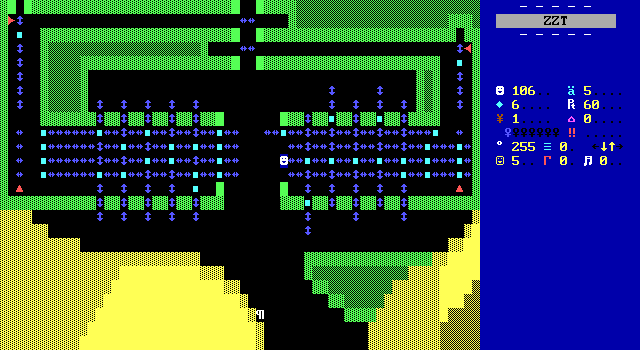
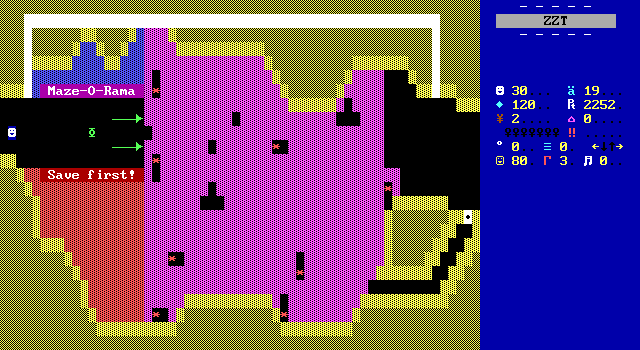
Just after the game splits into the two unique paths, but just before the player is actually locked into the one they've selected, they're presented with two puzzles: the "ancient sliding idol puzzle" or "Maze-O-Rama". Unsurprisingly, the maze is one of the few puzzles that could use a little work. The maze is just a perfectly ordinary fake wall maze, so there really isn't much offered here. You wander around until you find the way out.
Even so, I can give it a little more credit based on some of the smaller details and the greater context. The maze isn't entirely filled in with fakes and walls, so there's at least some guidance for the player as the assumption that these empty spaces are good stepping stones to the exit is a valid one. The maze also has its share of bonus objects in several of the dead ends. They're all identical and offer 1000 points a piece, so if you're actually score chasing the maze is quite prosperous. (Plus since it's before you're locked on a path, nothing stops you from getting the bonus points and taking the other path if that one ends up being better for points.) For players that aren't trying to set a high score, which I would say is the vast majority, these bonuses aren't all that exciting, but increasing a number certainly beats reaching a dead-end and getting nothing at all out of it.
Holub is also generous about the backtracking. Upon reaching the maze's exit the white solids along the top of the board are cleared, permitting a speedy trip across the board again if need be. This can even be helpful for those going for points that may find the exit before they reach all the bonuses.
Lastly though, what makes this maze feel far more acceptable than most comes down to the split paths. My complaint with mazes often boils down to them having no danger and therefore not doing anything but taking up time, but here that's a benefit. The alternative puzzle is one with sliders and boulders, and while the player isn't in danger of dying, they are in danger of configuring the puzzle in a way that renders it unsolvable. No matter what you do in the maze, you'll always be able to reach the exit eventually. In most ZZT worlds, messing up the sliding idol board would mean loading a save or starting from scratch. Instead, the player is free to just try this alternate path instead, where they don't have to worry about making mistakes. This time, the lack of danger is the entire point!
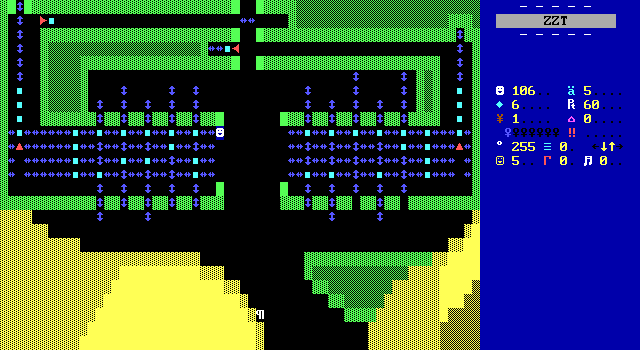
Meanwhile, for those not scared away the moment a slider shows up, the sliding idol room works out quite nicely. When the phrase "slider puzzle" is used, it tends to specifically refer to untangling a knot of sorts to open up a path for the player to traverse. Less frequently though, sliders get used for these locks that need to be unlocked by maneuvering sliders on one axis in order to be able to push sliders on the other axis. I find this style to be a lot more fun to solve where progress is much more readily measured. This kind of puzzle shows up in Town where it tends to be overlooked for the more complex and iconic Rube Board. It's a welcome change of pace, and the reduced difficulty common to this particular style of slider puzzle means that running into it so early is far more reasonable than starting the path off with something more daunting.

Speaking of surprisingly endearing mazes, one path leads to a phrase that brings fear into the heart of any grizzled veteran of ZZT: a multi-board maze. Yet Holub incredible pulls it off thanks to a smart implementation of a usually miserable design.
Once again, it's what different about this maze that makes it work. Looking at the atlas here things it's clear that it's barely a maze at all. The entrance board has two paths that promptly funnel to the lower left, shrinking what would first seem to be an eleven board maze down to eight. That's still a pretty big number of boards for a maze, but again the path is simple enough to hardly matter. Those remaining eight boards form a closed loop with only one branching path between them. Instead the player gets to navigate this massive space, but there really isn't any way to get particularly lost.
Other common pitfalls are avoided as well. The worst of the worst of these kind of mazes consists of purposely identical boards so the player struggles to figure out if they're making any progress at all. These boards are quite distinct, with creative contours that don't actually slow the player down much. The maze ends up feeling brisk, easily charted out mentally thanks to sensible (read: euclidean) connections and boards often having other areas of the path visible, helping you maintain your bearings.
It also doesn't shy from danger. The boards are infested primarily with centipedes that are the perfect foil for this kind of exploration focused area. They can usually be avoided, but there's always a risk that upon re-entering a board you've been on before that they'll be in a dangerous position. Whether you want to stop and shoot or keep moving is up to the player to decide. Some of the boards have narrow passageways as well that make them a more active threat than in the maze's earlier portions.
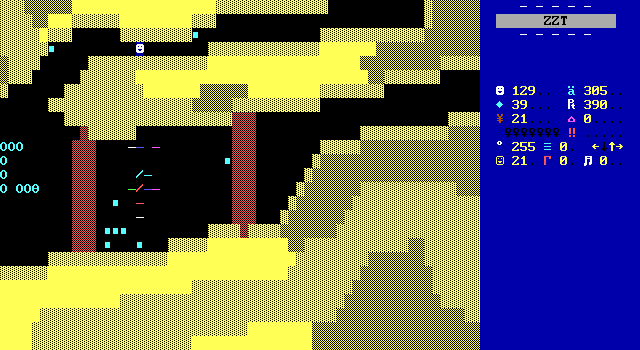
Oh, and this is a pyramid in a video game, so you know there have to be hidden traps.
The multiple paths work in the game's favor again. I lucked into the correct choice and avoided walls suddenly appearing and closing off an area that flooded with stars. There's not much like this in the maze, which is a shame because again Holub does it right. The walls appear in two phases so a player with fast reactions can possibly escape before the stars even appear. Those walls are made of breakables so you can shoot your way out immediately and don't really have to deal with the stars which can easily be lured into the remaining breakables. If that wasn't enough, the trap also leaves the player with quite a few boulders, allowing them to try and take shelter to hopefully mitigate the stars' reach. Or maybe you'll just get lucky like I did and end up on the top path and watch the stars harmlessly try to follow you through walls until they disappear.
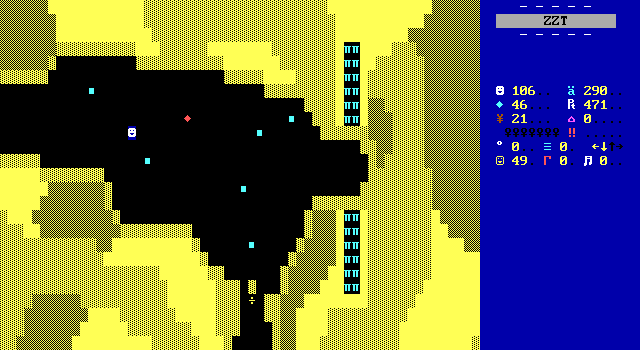
Other traps include a room that fills with slime, and this very weird tiger trap in which the player gets quickly surrounded by objects and dragged across the board to the corner with the tigers before the objects, and tiger blocking walls all vanish. This one actually can be dicey as unlike every other board in the maze, shooting is disabled entirely, which you won't be expecting until your gun suddenly fails you.
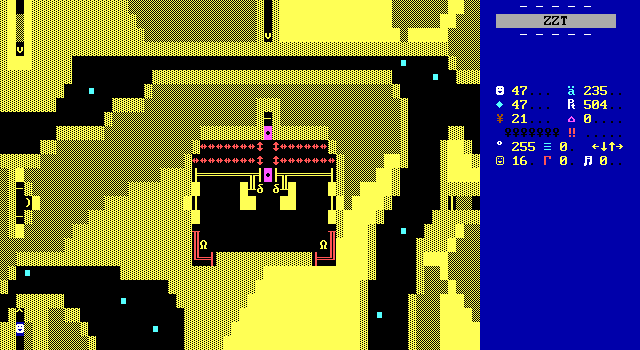
So the navigation of the maze isn't the difficult part, it's actually finding the exit that's the challenge. Here, I suspect things may get a little more divisive. The maze has a very clear goal of this inner chamber only reachable via transporters that clear is of some importance. It sticks out more than anything else in the maze and utilizes the various flavors of gold statues seen throughout the pyramid to make the room seem even more ornate. The story development is thin, but this is the Zakian gate, where the ancient pharaohs would communicate with none other than the deity Hussafuss.
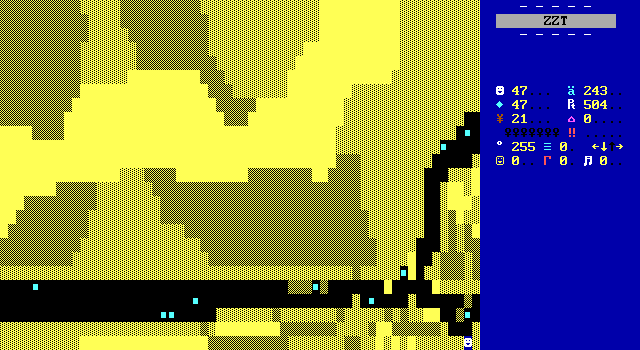
Getting inside requires thinking outside the box a little, or more accurately, thinking outside the maze. Fades in ZZT have always relied on solid to normal to breakable to water, and this has always been a fight against the rules of the engine as while the first two are plain walls, the latter two exhibit properties that you might not want them to have.
Breakables can be destroyed and water can be shot across or bumped for an awkward message about being blocked by water when it's intended to be part of a larger wall. How this should be handled in most games comes down to an agreement between player and author. It's usually clear when breakables are meant to be shading and when they're meant to be destroyed. Some games will just accept that the player can shoot up the scenery while others will more thoughtfully place the walls so that they can't be so easily destroyed.
Holub here is doing shading throughout the pyramid, always making sure to provide an outline to the wall to prevent the player effectively going out of bounds, but here that rule is purposely thrown out and the true challenge of the maze is to realize there is a spot that can be tunneled into, which leads to a secret passage across a few boards and transports the player to the Zakian gate.
This is again something I'd usually frown upon that Holub finds a way to make work. Since the player can see the gate and the transporter connections, it's clear that there must be some way to get in there. I think enough clues are given that once the player starts trying to figure out how the transporters all connect that they can reasonably be expected to find the stray breakables that open up the hidden path.
That being said however, the same board also has a second exposed seam into a large region of breakables that doesn't even contain so much as a hidden source of bonus points. That might throw people off the track and into thinking that the ability to get into the walls like this is a mistake. It doesn't help that the correct path doesn't introduce fake walls until the player attempts to walk off the edge of the board. If your mental map is good enough, you probably won't think that there's any potential for a connection to be made to an adjacent board. Still, on the other hand, even if your thought is "haha I got into the walls", why wouldn't you think "haha I wonder if I can actually make it onto an adjacent board with this unintentional path"?
I also have to raise one more objection to the maze, which is that the Zakian gate requires a sapphire to open, which is a perfectly reasonable request, but the player won't know that the maze leads to the gate until they get there. Obtaining the sapphire after reaching the gate means a significant amount of backtracking. I wound up using the file viewer to get an idea of where the sapphire was only to discover that I had already passed it, as it requires shooting breakables to get to a secret exit on a previous board as well.
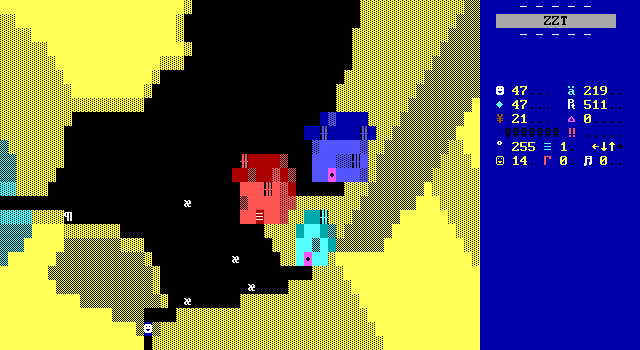
This kind of thing really needs to be hinted at in some way. The maze's seeming lack of a way to reach the exit may guide players to more unorthodox solutions like shooting into the walls, but the hidden path to the sapphire is something nobody would think is there over the far more plausible explanation of Holub missing a few normal walls after implementing his shading. Without a reason to think about shooting into the walls, players are all but guaranteed to miss this hidden exit.
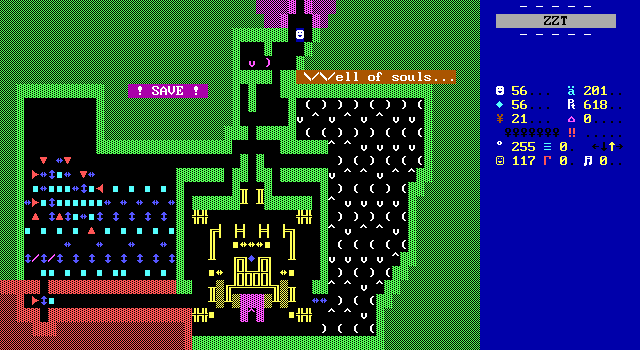
Once you've found the other path, then you're treated to a series of small puzzles, including the "Well of souls" which is some excellent themeing. I really love the arrangement of this room. The sapphire is protected by blink walls which make it impossible to push the lower two sliders to be able to push the slider that blocks the sapphire itself. Two smaller puzzles have to be solved first, one a traditional slider puzzle and the other a transporter maze.
In practice, neither of these are particularly impressive. The transporter maze is just that. Missteps require a reload, and the arrangement of the room means you might have to go through it a second time if you don't realize that the order of this open-ended looking puzzle is actually important. I always found zipping through transporters to be pretty satisfying thanks to the great sound they make when used, but that doesn't save the annoyance of having to run through it twice.
The slider puzzle is a complete dud. That whole rat's nest of pushers seems to be the intended solution. I imagine that you can unravel things in such a way to get a pusher to move south and activate the bottom pusher to block the left blink walls.
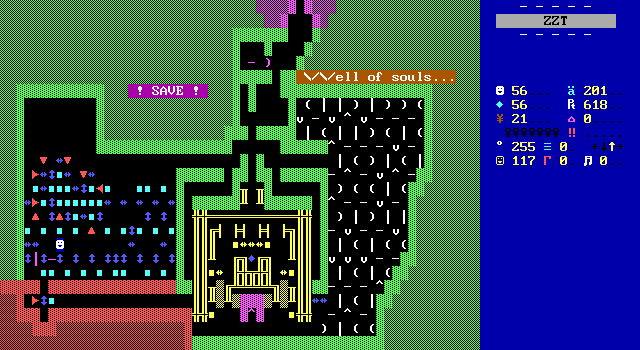
But, why bother with that? It's trivial to just go around it and set the pusher in motion yourself making Holub's attempt at a non-lock style slider puzzle remain unsolved.
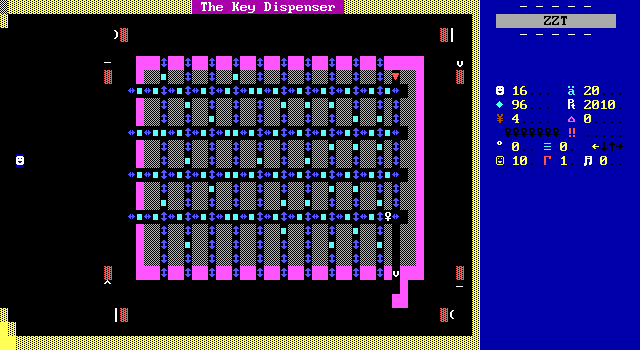
For the grand finale of one northern path, the player must solve "The Key Dispenser". This is yet another lock-style slider puzzle that I really wish wasn't on the same path as the initial one. Given the split nature of the game I really don't get why one path would have two of the same puzzle instead of splitting them up one and one. It might make sense if this split path was more along the lines of Evil Sorcerers' Party where the player is at one point asked to choose between two paths, one focused on action and one focused on puzzle solving. Both the paths in The Lost Pyramid are hybrids so making the switch would be feasible.
Otherwise, the idea is still good, and there's some extra thought given to caring for the the player, but with a bit of problem in execution. On seeing this, I was impressed that Holub had the thought to include transporters to let the player move around the much larger puzzle more rapidly. I am definitely grateful for it. Nevertheless, an extra set of transporters in the middle running vertically would have really be nice, and there's no reason not to just go all out and line that entire purple border with transporters to really let the player focus on sliding sliders and not getting from point A to point B.
That's a nitpick, and quite frankly most ZZT games wouldn't do any transporters on a puzzle like this at all.
The puzzle does have a fatal flaw though:
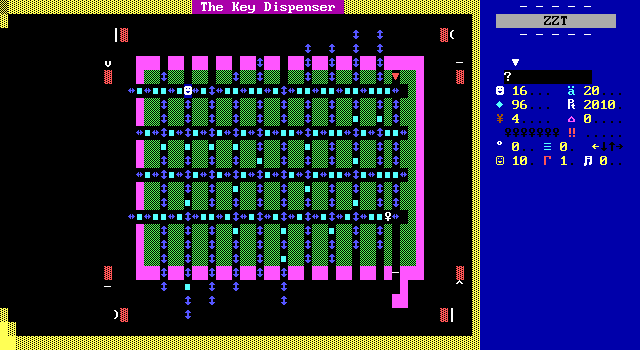
It's not tall enough!
While just trying to solve things normally, I realized you could push these columns so far down that you could get inside the actual mechanism for the puzzle!
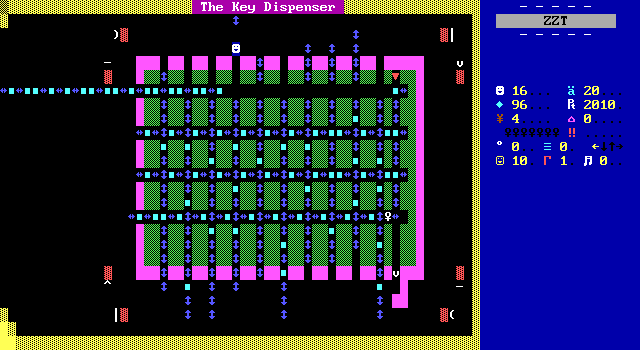
Which can greatly simplify things! The more you can shove aside, the less puzzle there is to actually solve. In fact, from the start you can just push the rightmost column all the way down, go to the bottom and push away a boulder, and then push the column all the way back up. After messing with just a single column you can grab the key yourself.
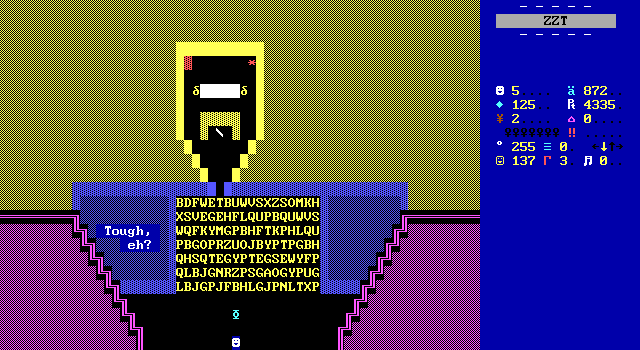
Another puzzle that stands out from the rest is the tomb puzzle shown here, which focuses on objects rather than built-in puzzle elements. A few boards prior the player is given the hint needed to complete this puzzle, which otherwise I doubt would be solvable so much as brute-forced. The hint, which is devoid of context simply reads Stand on the mirror image of EGYPT.... I think it works overall as the clue to me made me expect some geography puzzle or something rather than the letters shown here.
Of course, if you don't make that connection, you're just stuck guessing until you make the connection and probably won't enjoy this.
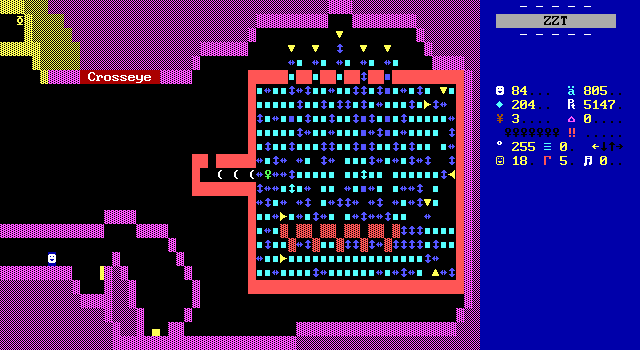
Despite complaints about the second locking puzzle on the northern path, the eastern path handles things worse. "Crosseye" is a slider puzzle of a third variety, where the player is given a limited number of mechanisms outside to activate, and they have to find the correct order to push them. The idea here is that you'll get the green key out and be able to open a locked door seen earlier that holds a mysterious cyan key behind it.
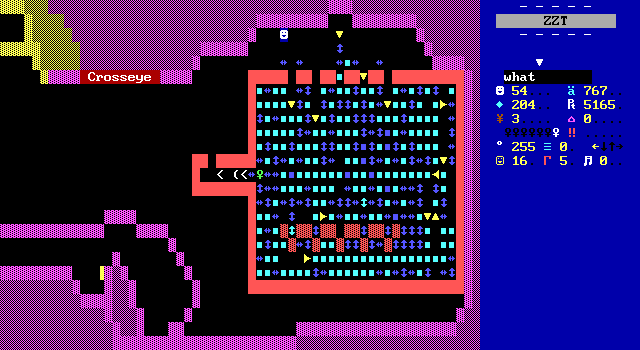
Problem: You can't get the key out. Since the rightmost transporter is blocked in the direction it points, it will only transport if it can find a transporter that faces the opposite direction, which it won't. This renders the the puzzle unwinnable! This would be a really tragic end to an otherwise quite solidly built game, except the entire puzzle is actually a red herring???
Yeah, you can cheat and grab your green key, open the door with it and obtain the cyan key. That's when you'll discover that there isn't a cyan door anywhere. It's just there either to fool the player entirely or as a leftover for some cut content that never got made for the game. Fortunately, the white key being held in this screenshot is the final key to open the door to the idol of Hussafuss and allow the game to be completed, so you can still get through the eastern path without having to cheat as well. You just end it in this weird state with a puzzle that gets entirely ignored and seeing a locked door with a key behind it that ends up being meaningless.
It's really weird to me that this is how the eastern path winds down. This puzzle needs to have one of the two touching transporters erased (or flipping the left one to point right). Do that and it fully functions as intended, and it's a fun little puzzle to solve that's easily on par with the numerous others seen across the game. Having this be here when it's not meant to be solved is just such a bizarre decision to me, and a big part as to why I think the northern path is the better of the two.



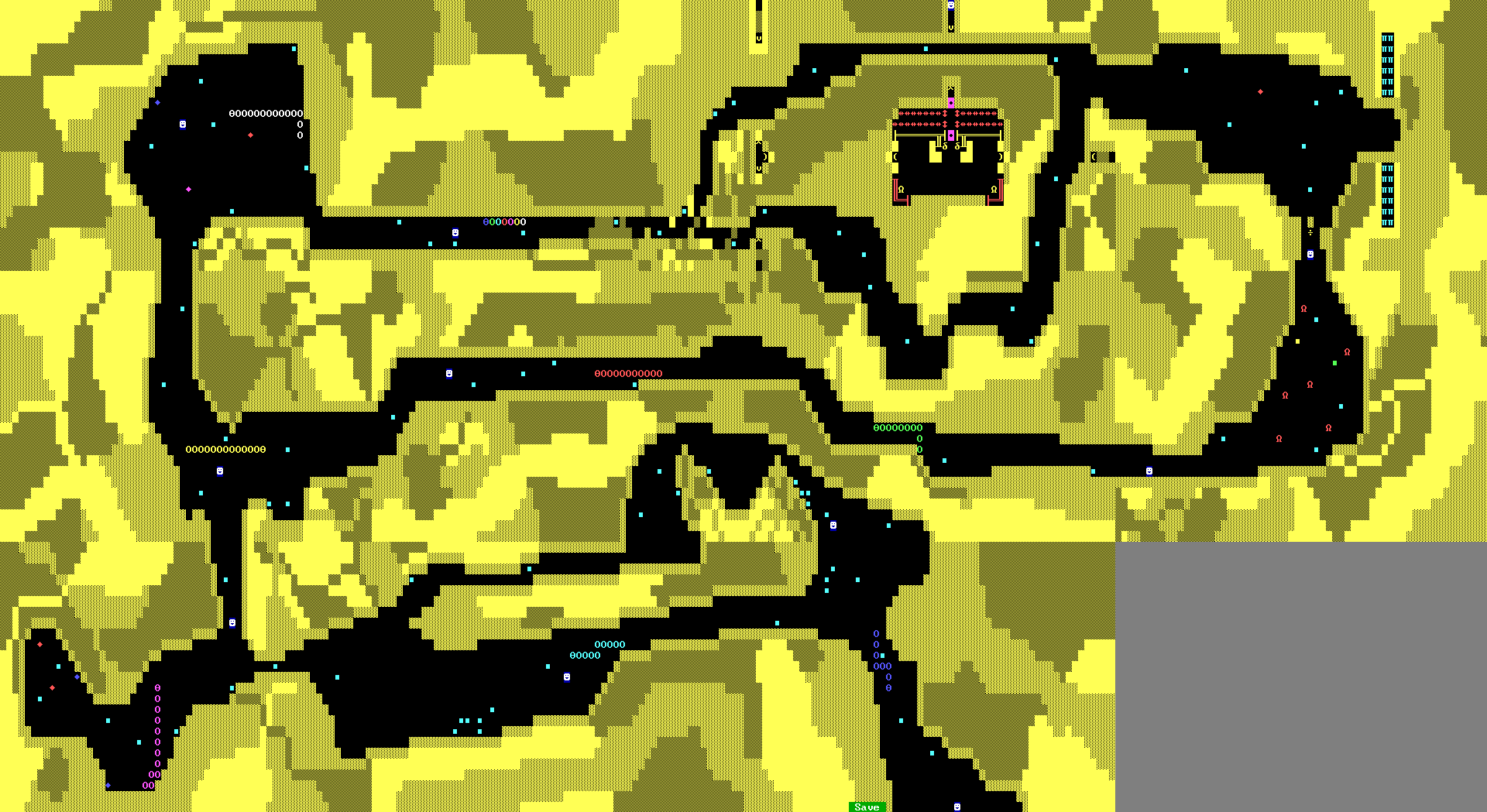 Click for full
Click for full